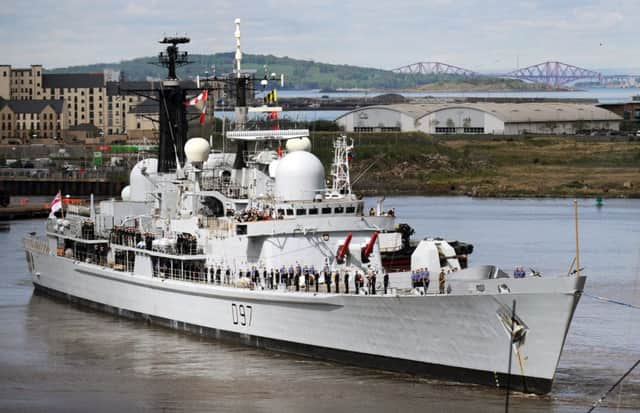HMS Edinburgh sets sail for scrap in Turkey


It had been hoped that HMS Edinburgh, the last of the Royal Navy’s Type 42 destroyers, would find a new home in Leith.
But after proposed costs for the venture were deemed too high, the ship – the largest in its class – was sold to a Turkish scrap merchant, a fate which befell her sister ships, HMS Manchester and HMS Liverpool.
Advertisement
Hide AdAdvertisement
Hide AdMaritime enthusiasts and members of the Navy gathered yesterday afternoon to bid the 463ft vessel a final farewell as it set sail from Portsmouth.
Known as the ‘Fortress of the Sea’, the ship – built in 1980 by the Cammell Laird yard at Birkenhead, Merseyside – was deployed to the Gulf in 2003 during the Iraq war, escorting helicopter carrier HMS Ocean and supporting Royal Marines ashore. She underwent a £17.5million refit in 2010 but was decommissioned three years later.
A senior officer who had operational command of HMS Edinburgh said the ship’s journey to the breakers marked the “end of an era” but admitted there was no practical alternative.
Rear Admiral Philip Wilcocks, chairman of the Type 42 Association, an organisation for those who have served aboard the destroyers, said: “HMS Edinburgh had had a very great career. She was part of my fleet when I was captain of the 3rd Destroyer Squadron and she is remembered with great affection.
“It is the end of an era, but the threat has changed in the 21st century and requires Type 45s, modern ships with modern weapon systems to deal with it.”
After the ship came out of service, a social media campaign, Save HMS Edinburgh, attracted nearly 2,500 supporters.
Edinburgh City Council commissioned a report to establish whether it was viable to preserve it in Leith, either as a standalone attraction, a joint facility run by the management team of HMY Britannia, or as part of a wider maritime project.
Advertisement
Hide AdAdvertisement
Hide AdHowever, the study carried out by Pricewaterhouse Coopers concluded that the costs would be too great. The cost of buying the ship was put at £625,000, while bringing it to Leith would cost a further £440,000.
Converting and restoring the destroyer, it added, would result in a bill of around £9.15million, with a minimum of £4million in ongoing operating costs.
Even with ticket sales included, the report estimated that the attraction would operate at a loss, stating: “There does not appear to be any reasonable basis by which the public sector could support the project on value for money terms.”
Lord Provost of Edinburgh Donald Wilson said at the time: “I am obviously disappointed that we could not in the end bring HMS Edinburgh to the city.”
Separate plans by the National Maritime Trust to have the ship moored at Falmouth docks as part of a Falklands Memorial Fleet museum also ended in disappointment.
Rear Admiral Wilcocks added: “Trying to save a Type 42 destroyer is an extraordinary challenge. It’s incredibly expensive trying to keep a warship and people have tried it in the past, such as with HMS Plymouth. If you saw how that ended up, it’s not something the association would have liked to have seen happen to HMS Edinburgh.
“It’s challenging enough for Edinburgh to look after a former Royal yacht. To have a destroyer as well would have posed an extraordinary challenge for the city to find the funds to keep it going.
“People get very emotional about lumps of steel, but the heart of a destroyer is its people and the thousands who served on HMS Edinburgh will remember her with great fondness.”